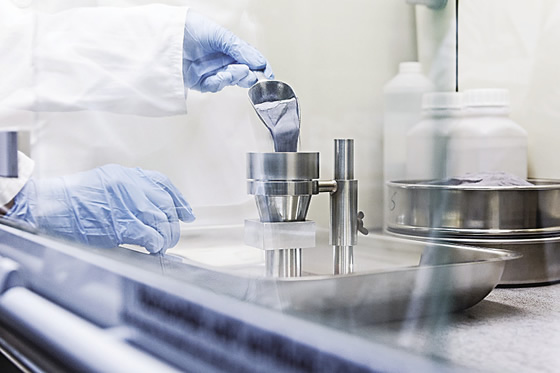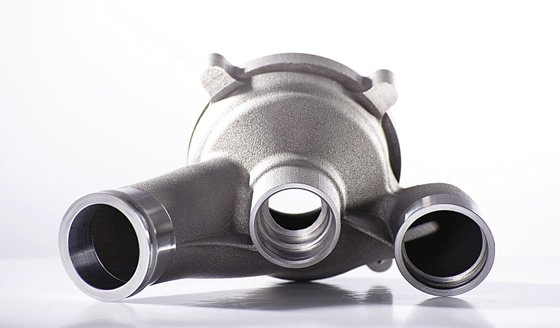As laser powder bed additive-layer manufacturing of metal parts continues to make the leap from rapid prototyping to series production, metal powder manufacturers are responding with new materials that rival the performance of the highest-grade foundry products. Scalmalloy, a new aluminum-magnesium-scandium alloy from Airbus APWorks GmbH, is one such offering, according to the company.

Scalmalloy is an aluminum-magnesium-scandium powder from Airbus APWorks. Image courtesy Toolcraft.

Toolcraft produced this automotive pump housing via metal laser melting. Image courtesy Toolcraft.
The corrosion-resistant material reportedly has the specific strength of titanium at a simultaneously high ductility and is more than twice as strong as the aluminum-silicon powder currently in use. Scalmalloy’s ultimate tensile strength is 490 MPa, yield strength is 450 MPa and elongation at break is 8 percent.
“Airbus realized that the mechanical properties of AlSi10, the standard additive manufacturing aluminum alloy, are not sufficient to be used in aerospace applications,” said Angela Grünewald, who’s in charge of business development for Airbus APWorks, which also prints parts. “The need for a high-strength AM aluminum alloy was identified. During the process, a lot of testing of slight chemical modifications, as well as testing of different powder production processes, was done.”
In addition to aerospace parts, such as interior ones, Grünewald noted Scalmalloy is suitable when parts require a combination of high-strength and lightweight properties, including ones for the automotive and robotics industries.
MBFZ toolcraft GmbH is another manufacturer that uses Scalmalloy to 3D print those types of parts. According to Managing Director Christoph Hauck, toolcraft uses an innovative process in which the design data for manufacturing a part is divided into cross sections, which are then formed on top of one another during the laser-melting process.
“Due to a special construction process in which the laser jumps back and forth between predetermined melting points, the precision part is produced with a low amount of tension,” he said. “Heat treatment follows the completion of the manufacturing process and makes the final workpiece completely free of tension and ensures it possesses the desired mechanical properties.”
Grünewald noted the powder is suitable for printing on AM machines from different builders.
Typically, a near-net shape printed workpiece must be turned or milled, as well as polished, to finish it. “The machinability of Scalmalloy is similar to classical high-strength aluminum alloys,” Hauck said.
For more information about Airbus APWorks GmbH, Ottobrunn, Germany, call +49 89-607-28237 or visit www.apworks.de. For more information about MBFZ toolcraft GmbH, Georgensgmünd, Germany, call +49 9172-69-56-0 or visit www.toolcraft.de.
Related Glossary Terms
- alloys
alloys
Substances having metallic properties and being composed of two or more chemical elements of which at least one is a metal.
- aluminum alloys
aluminum alloys
Aluminum containing specified quantities of alloying elements added to obtain the necessary mechanical and physical properties. Aluminum alloys are divided into two categories: wrought compositions and casting compositions. Some compositions may contain up to 10 alloying elements, but only one or two are the main alloying elements, such as copper, manganese, silicon, magnesium, zinc or tin.
- ductility
ductility
Ability of a material to be bent, formed or stretched without rupturing. Measured by elongation or reduction of area in a tensile test or by other means.
- elongation
elongation
In tensile testing, the increase in the gage length, measured after fracture of the specimen within the gage length, usually expressed as a percentage of the original gage length.
- lapping compound( powder)
lapping compound( powder)
Light, abrasive material used for finishing a surface.
- machinability
machinability
The relative ease of machining metals and alloys.
- mechanical properties
mechanical properties
Properties of a material that reveal its elastic and inelastic behavior when force is applied, thereby indicating its suitability for mechanical applications; for example, modulus of elasticity, tensile strength, elongation, hardness and fatigue limit.
- robotics
robotics
Discipline involving self-actuating and self-operating devices. Robots frequently imitate human capabilities, including the ability to manipulate physical objects while evaluating and reacting appropriately to various stimuli. See industrial robot; robot.
- tensile strength
tensile strength
In tensile testing, the ratio of maximum load to original cross-sectional area. Also called ultimate strength. Compare with yield strength.
- yield strength
yield strength
Stress at which a material exhibits a specified deviation from proportionality of stress and strain. An offset of 0.2 percent is used for many metals. Compare with tensile strength.




